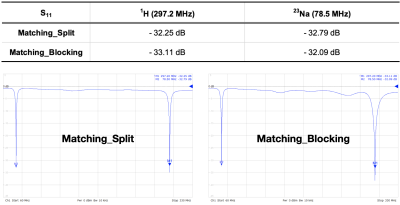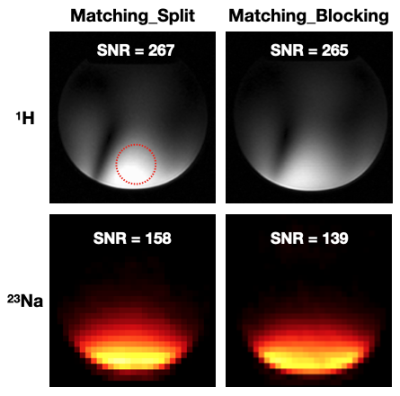3311
A comparison of double-matching networks in a double-tuned coil for multinuclear MRI1Institute of Neuroscience and Medicine - 4, Forschungszentrum Juelich, Juelich, Germany, 2RWTH Aachen University, Aachen, Germany, 3Institute of Neuroscience and Medicine - 11, Forschungszentrum Juelich, Juelich, Germany, 4JARA - BRAIN - Translational Medicine, Aachen, Germany, 5Department of Neurology, RWTH Aachen University, Aachen, Germany
Synopsis
X-nuclei MR offers unique information relating to cellular and metabolic processes in tissues. Multi-tuned coils are frequently utilised for X-nuclei measurements, and a number of novel approaches for double tuning coils exist. However, designing a well-performing multi-tuned coil is challenging, and making any improvement in SNR is particularly desirable on the X-nucleus coil due to the intrinsically lower MR sensitivity of X-nuclei. This study focuses on the insertion of double-matching networks in a single-structure, double-tuned 1H/23Na coil and compares their effect on the coil performance. The double-matching networks were built using either split or blocking traps.
Introduction
Corresponding with the increasing availability of ultra-high field systems, the combination of X-nuclei with proton MRI is currently of great interest as a means of accessing valuable biochemical cellular and metabolic information in tissues.1 Due to the lower intrinsic sensitivity of non-proton nuclei compared to 1H, it is important to ensure that the signal-to-noise ratio (SNR) of the X-nuclei is as high as possible, and any improvement is desirable. Several approaches exist for double tuning single-structure coils, with some requiring a double-tuned matching network.2-4 Although the effect of the tuning traps (attached to the coil for double-tuning) on coil sensitivity has been previously demonstrated in the literature, to the best of our knowledge, no studies have explored an effect on resonator performance, influenced by an inserted double- or multiple-matching network. In this study, we compare the effect of the different double-matching networks on a frequently used double-tuned coil built with trap circuits.Materials and methods
As shown in the schematics in Fig. 1 (left), we initially designed two identical, double-tuned, 1H/23Na coils using trap circuits without inserting any matching network. In order to ensure the quality of these foundation coils, we measured the Q-factors on the bench using a double-sniffer loop and a network analyser before adding any matching network. Thereafter, the planned matching networks were constructed and implemented in the double-tuned coils. Fig. 1 (right) shows the two proposed matching networks5,6 evaluated in this study: Matching_Split and Matching_Blocking. In order to achieve good impedance matching, the double-matching networks included either split or blocking traps. Here, the split trap allows current to flow at both predetermined frequencies, whereas the blocking trap restricts one of the frequencies and in our case, it blocks the 1H frequency. Fig. 2 summarises the matching conditions on an ordinary 2-litre cylindrical phantom - here, we were able to achieve matching better than -30 dB for both the 1H and 23Na frequencies. This was then further evaluated using a 7 T Terra (Siemens Healthineers, Germany), whereby the corresponding Larmor frequencies are 297.2 MHz for 1H and 78.5 MHz for 23Na.Results
The Q-factors of the base double-tuned coils were almost identical within experimental error: unloaded Q = 104 for 1H and 240 for 23Na, loaded Q = 51 for 1H and 143 for 23Na and Q ratio = 2 for 1H and 1.7 for 23Na, which confirmed that there was no quality difference between two base coils. Fig. 3 shows 1H and 23Na images acquired using 2D and 3D FLASH sequences, respectively. The imaging parameters for proton // sodium were: TR = 8.6 // 25 ms, TE = 3.69 // 3.63 ms, No. of averages = 1 // 32, slice thickness = 1 // 4 mm, In-plane resolution = 0.5 × 0.5 // 4 × 4 mm2, and the acquisition time = 10 seconds // 7:02 minutes. Relative SNR values for 1H and 23Na images measured using both double-matching networks are also shown (1H: 267 (Split) // 265 (Blocking) and 23Na: 158 (Split) // 139 (Blocking)). These were measured and calculated at the selected region of interest (red dotted circle in Fig. 3) using the mean signal divided by the noise standard deviation - outside the phantom area. It was found that the SNRs of 1H using both double-matching networks were almost identical, while those of 23Na were appeared to be different by approximately 10%; the split matching trap provided a slightly higher SNR.Discussion/Conclusions
In this work, we have demonstrated the effect of added double-matching networks on a single-structure, double-tuned coil. Based on previous literature results2 associated with the evaluation of inserted double-tuning traps, we anticipate that the double-matching networks may create some level of additional sensitivity loss. Thus, it is important to consider the design of the matching network carefully when constructing double- or multi-tuned coils. In future studies, it would be beneficial to compare the proposed double-matching networks to a single-matching network as a reference. Furthermore, investigating other potential double-matching approaches, e.g., using PIN-diode circuits7 or LCC traps8, as well as optimising the inserted trap inductor9, would also be useful, as these could significantly contribute to the coil sensitivity.Acknowledgements
No acknowledgement found.References
1. Worthoff WA, et al., Multinuclear MR imaging and spectroscopy. In: Cercignani M, Dowell NG, Tofts PS, editors. Quantitative MRI of the Brain. Boca Raton: CRC Press; 2018.
2. Choi C-H, et al., The state-of-the-art and emerging design approaches of double-tuned RF coils for X-nuclei, brain MR imaging and spectroscopy: A review, MRI, 2020.
3. Dabirzadeh A, McDougall MP, Trap design for insertable second-nuclei radiofrequency coils for magnetic resonance imaging and spectroscopy. Concepts Magn Reson B 2009.
4. Rowland BC, Driver ID, Tachrount M, et al., Whole brain 31P MRSI at 7T with a dual-tuned receive array. Magn Reson Med 2020.
5. Schnall MD, Subramanian VH, Leigh JS, Chance B, A new double-tuned probed for concurrent 1H and 31P NMR. J Magn Reson 1985.
6. Wetterling F, et al., The design of a double-tuned two-port surface resonator and its application to in vivo hydrogen- and sodium-MRI. J Magn Reson 2012.
7. Choi C-H, Hong S, Ha Y, Shah NJ, Design and construction of a novel 1H/19F double-tuned coil system using PIN-diode switches at 9.4T. J Magn Reson 2017.
8. Meyerspeer M, et al., An improved trap design for decoupling multinuclear rf coils. Magn Reson Med, 2014.
9. Isaac G, Schnall MD, Lenkinski RE, Vogele K, A design for a double-tuned birdcage coil for use in an integrated MRI/MRS examination. J Magn Reson 1990.
Figures


